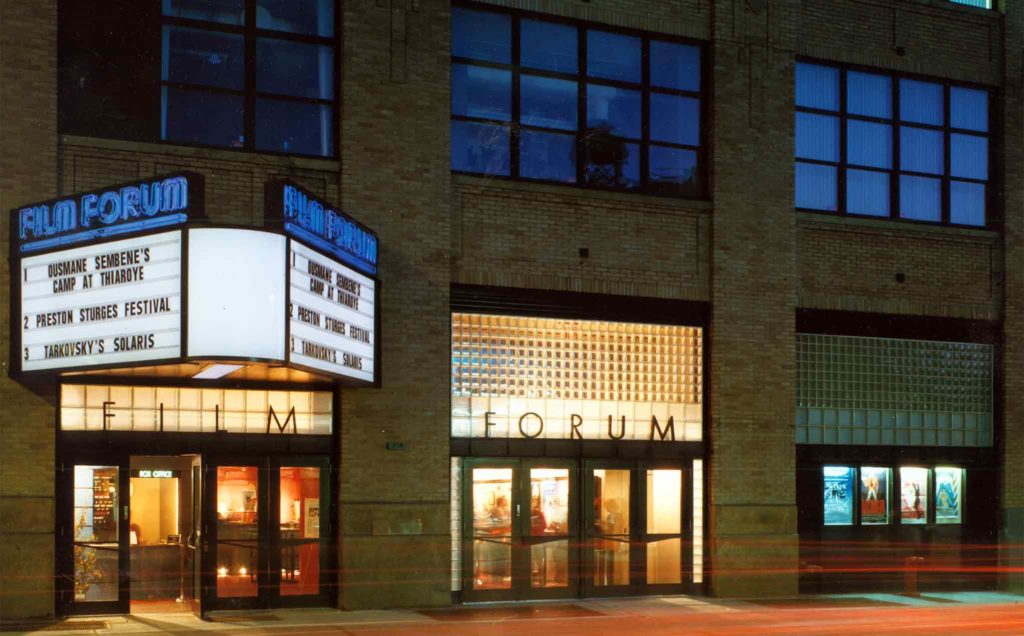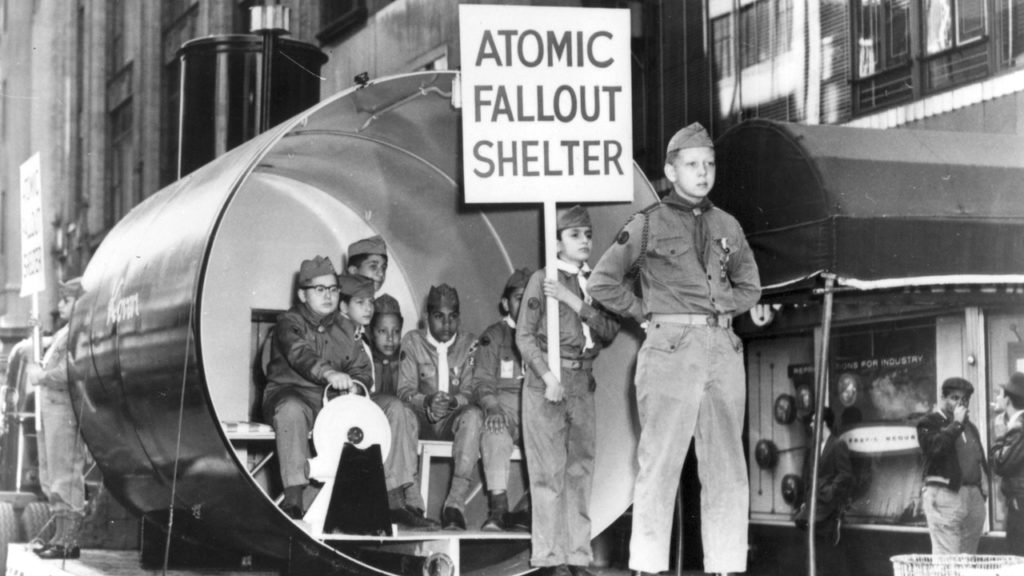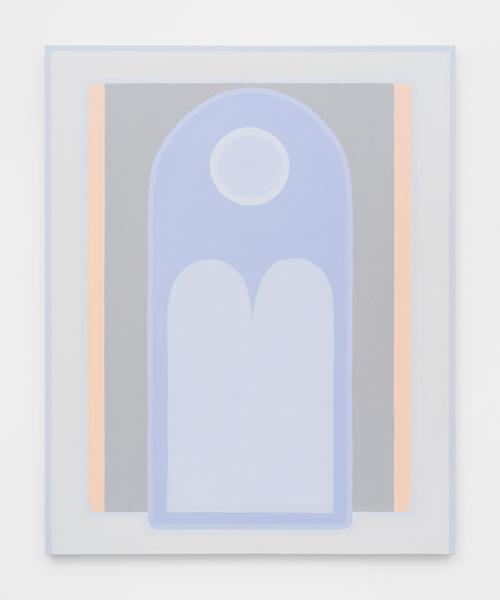If you recently found yourself wandering West Houston and Sixth, did you notice the soft sounds of film reels spinning and popcorn popping? If you didn’t, then you weren’t listening hard enough, because Film Forum is reopened for business after its renovation hiatus. Among some of the films stretching the legs of the new theaters are Nico, 1988 (which you can read about on the Daily) and a long schedule of films by the French director Jacques Becker. On Saturday night, I saw Rendezvous in July (Rendez-vous de juillet), a 1949 comedy of jazz-loving, Bohemian-lite young Parisians. Lucien is in love with Christine and wants to go abroad to make a documentary film; Roger is a brooding, brass-playing musician in love with the actress Therese, who will be starring alongside Christine in a hot new play. When these bright young things aren’t dancing in jazz clubs or having dinner parties, they’re navigating their lives away from the strictures of their bourgeois parents’ generation and forward into a new world after the war. At its heart, Rendezvous in July is a wonderful, quick-witted movie about young people, about Paris, about art and love. This was the first film I’d seen by Becker, and I hope to see another. However, if Rendezvous in July doesn’t pique your interest, I’m sure any of the embarrassment of film riches once more available would be reason enough to walk through Film Forum’s recently reopened doors. —Lauren Kane
Nostalgia is not an emotional condition that holds much sway for me, so the ways in which the eighties have recently appeared in fiction and film have often left me feeling bewildered. The characters in Claudia Dey’s Heartbreaker are caught in a perpetual 1985 by dint of their cultish isolation from humanity’s mainstream. But Dey’s project is far more ambitious than asking the reader to feel a pang of longing for the past. Her characters are trapped in a time machine of their own making, defining the world as fallen and then forming their own frozen version of it in reaction, as if in doing so, the world will be unable to fall further into hellfire. A fierce exploration of memory and zeitgeist peopled by characters named Pony, Supernatural, and The Heavy and partly narrated by the family dog, Heartbreaker is a darkly comedic weirdo of a book that pulls the string of nostalgia from one side while unraveling it from the other. —Christian Kiefer
The voice of an era distills as we hurtle ahead and away from it. In photos taken from Saturn, the Earth looks merely faintly blue. From an entire world of art and events, a few things, then fewer and fewer, are saved to become exemplary of their time and place, while the rest are buried and compressed like a geological stratum under new events, new art. The few representative pieces are sometimes kept intentionally, for their quality, and sometimes by chance, like the unremarkable domestic pottery that happened not to break over the millennia. Together, they create the flavor and sensibility of an epoch. What we continue to hold in regard is not a reflection of then but of now, of our sensibility, the qualities we choose to admire or denigrate. To rely on solely the canonical works to get a sense of another time is a deformation: the bad works of art, the forgotten works of art make up a constituent element of their time as much as, if not more so than, the works of genius. This is all to say that the 1982 documentary The Atomic Café, now playing at the refurbished Film Forum, is many things—history of the first decade of the atomic era, black comedy, exploration of the paradoxes of the American temperament—but it is also a vital rescue of the resolutely bad art of that epoch—the military propaganda, the television specials, the dryly delivered political addresses. Pieced together by Jayne Loader and the brothers Kevin and Pierce Rafferty from archival television broadcasts and military films, The Atomic Café is a bath in the ambient media of the late forties and fifties, a portal into the anxiety of the age, an anxiety blunted for us in 2018 by a nearly seventy-five-year interval in which nuclear weapons were never unleashed. Great movies of nuclear anxiety like Dr. Strangelove have been assimilated into our sensibility, their ironic and detached tone familiar, but watching a maladroit instructional video in which a generic sitcom father resolutely gathers his family in their fallout shelter feels jagged, close to the bone. Its uncannily sedate terror feels much nearer to the close air of those years. —Matt Levin
My litmus test for drinking while reading is that when I notice I’m squinting at the book with only one eye open, it’s time to go to bed. Drinking from reading, however, is a different story. I’ve written about wines mentioned by Alexandre Dumas in The Three Musketeers and Homer in the Iliad for my Eat Your Words cooking-from-literature column for the Daily. And I’ve learned that when I need to track down a beverage from a classic book, I’m often able to find a close modern-day equivalent. Many wine and spirits makers are turning to vintage and low-tech forms of production and coming up with funkier and more complex beverages that are more like what people would have been drinking centuries ago. If you want a wine that looks and tastes like what Telemachus serves the disguised Athena in the opening scenes of the Odyssey, you can probably find one from a grape and region that would have been available to him, produced in essentially the same way. New Yorkers are exceptionally fortunate to have an Odyssey-inspired wine and tasting menu running through August at the Ruffian Wine Bar (125 E. Seventh Street). The owner Patrick Cournot advised Eat Your Words on the Iliad story, and is now doing his own spin with wines from the Odyssey, plus an ancient Greece inspired tasting menu to accompany them. Ruffian specializes in trendy, organic, small batch bottles from cult European vintners located in regions found in the Odyssey. The tasting menu offers, as Homer puts it, “many good things of what there was in the house,” and “all manner of meats.” Unfortunately, the wine will not be poured out in “cups of gold” as specified but…a few things have changed since antiquity. —Valerie Stivers
In the late ‘70s, Peter Sellers was filming in Paris, and having a miserable time, so he called his agent at CAA, and demanded that the agent re-hire a producer Sellers had recently fired, for reasons he could no longer remember. The agent said, “Of course, Peter,” then ordered his assistant to find the producer and get him on a flight to Paris that night, or else the assistant would be fired. The terrified assistant desperately called every fancy restaurant in Hollywood, until, miraculously, he got the producer on the phone. By that time, though, the last flight to Paris was leaving in 12 minutes, and the producer wasn’t packed. He hadn’t even finished his dinner. “There was a payphone in the basement of our building at 1888 CPE,” Fields remembers, “and I had seen on Dragnet as a kid that supposedly if you use a pay phone and you put a handkerchief over it and you hang up within three minutes, they can’t trace the call. So I called up the airline and called in a bomb scare to the delay the plane and hung up. Then I went back upstairs, called the airline, and a recording says, ‘Flight to Paris delayed.’” This anecdote is from the addictive oral history Powerhouse: The Untold Story of Hollywood’s Creative Artist Agency by James Andrew Miller. At the center of the story, is Michael Ovitz, the youngest of the agents who seceded from the William Morris Agency to found CAA, a hipper, more collaborative agency.I hadn’t heard of Ovitz before reading this book, but he was arguably the most powerful man in Hollywood throughout the ‘80s and ’90s. His rise and fall is like that of a French king, or Roman emperor. CAA eventually came to represent everyone from Steven Spielberg to the Ghostbusters franchise to Toms Cruise and Hanks to Fleetwood Mac, and ER, and the Coca Cola commercials with the polar bears wearing sunglasses. The narrative spans from the 1960s to 2016, but throughout the decades, there is at least one constant: no one ever announces to their boss that they are going to leave CAA. Whenever they’re even just considering it, word somehow makes its way upstairs. Verbal bloodbaths occur every ten pages. It’s the same with clients. When screenwriter Joe Eszterhas (Basic Instinct, Show Girls, Flashdance) tries to break his contract, he claims Ovitz says, “My foot soldiers who go up and down Wilshire Boulevard each day will blow your brains out…I don’t care if I win or lose, but I’m going to tie you up with depositions and court dates so that you won’t be able to spend any time at your type writer. If you make me eat shit, I’m going to make you eat shit.” The book is 700 pages, and it’s still too short. —Brent Katz
I experienced the new Cheim & Read show, All over the moon as a Monty Hall problem for an audience lured by the title’s promise of joy, a sort of trilemma of the liberated imagination. The three artists, Laurel Sparks, Lily Stockman, and Richard Tinkler, all work in the abstract. The show is curated by Jack Pierson, and the intrigue rests on the fact that the three showcased visions of being, each in separate rooms, seem difficult to synthesize. In the largest room, Richard Tinkler’s oil paintings have an extravagant, consciousness-expanding style, using geometrics and symmetries that nonetheless depict a seductive sense of chaos, a portal to getting lost. In the adjacent room, we leave behind Tinkler’s daunting cosmic expressionism for Laurel Sparks’s assemblages of glitter, paper maché, crayon, ash, beads, and beyond. Her work shares Tinkler’s spontaneity, but the diversity in materials brings an infantile state of play to the canvas. Her pieces call to mind a child’s arts and crafts sensibility, imbued with talismanic shapes, suggesting transcendental properties of play. The final room belongs to Lily Stockman, who works with oil on linen. She holds degrees in painting and botany, and studied Buddhism in Mongolia. Her muted hues and smooth textures bring a relieving visual silence after the stimulation of the prior rooms, and her formal studies all come together on the canvas. The eye and mind may rest here, especially within Jordan Pond, my favorite piece of the show. As I left the Stockman room and then the gallery, I thought of a Talking Heads line: “Heaven is a place/where nothing ever happens.” —Ben Shields
Every day, as I walk to the office of the Review, I pass dozens of changeable letter signs in big block type: “Wine is survival juice,” one shouts, advertising $7 happy hour. Down the street another encourages me to attend “wine therapy,” and still another informs me that “A banana is 105 calories and a Prosecco is 80,” and that I must “Choose wisely.” It’s hard to imagine a world where alcohol is not cheerily, insistently, equated with joy and celebration, sloshed across subway ads and doled out at parties. But in Nothing Good Can Come From This, Kristi Coulter sees through it all. “Why would anyone want to soften the edges of this glorious reality?” she asks, while drowning herself in a bottle of wine a night. You can practically hear the sarcasm she slathers on the page, the unflinching voice with which she narrates her journey towards sobriety. But her essays aren’t just about weaning off the booze— they’re about what created the need for the bottle-a-night habit to begin with. Coulter challenges “a lifetime of conditioning” in a society that demands her to sacrifice her identity because of her gender. With caustic wit and a renewed, sober vigor, Coulter lets us know that there might be hope for us after all. —Madeline Day
from The Paris Review https://ift.tt/2vB08wx



Comments
Post a Comment